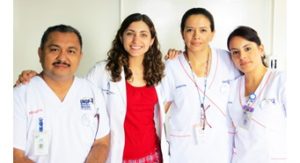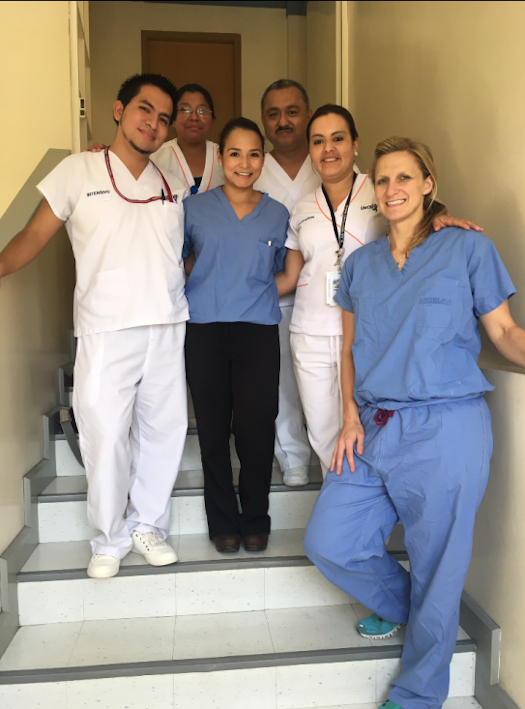Guatemala | Overview
Pressure Injury Prevention at a Pediatric Oncology Hospital
Challenge
During our initial involvement with UNOP (Unidad Nacional de Oncología Pediátrica, a pediatric specialty hospital) we had started a medication adverse tracking system project. Together with our local partners, we saw an opportunity to expand our work together to reduce the high incidence of pressure injuries in the intensive care unit.
Where We Started
Pressure injuries in the ICU were common in patients and often a long-lasting sequalae of their critical illness. In collaboration with the education and ICU nursing team in UNOP, and with mentoring from our own MSICU Clinical Nurse Specialist, we performed a pressure injury prevalence survey and assessed every patient in the ICU as well as all pressure relieving surfaces such as mattresses, bed air pumps, positioning devices, etc. We also found that though the ICU team had some prevention strategies in place, they lacked a consistent guide for risk assessment, prevention strategies, and treatment in case a pressure injury did occur. They also lacked the appropriate pressure relieving surfaces and wound prevention supplies.
Our Impact
Since our initial assessment, we introduced the use of the Braden Q scale, a skin assessment tool, to nursing staff. This started the change in practice to identify patients who would be at high risk for developing pressure injuries. The unit has adopted the use of the Braden Q assessment for every patient, every day, and with education on nursing interventions for pressure reliving strategies, they have become more common practice for every patient. In collaboration with UNOP ICU physicians, patient mobilization orders are provided for every patient, depending in their level of clinical acuity. Since our first visit with collaboration with a Boston Children's Hospital mattress vendor, we were able to donate eight new pressure relieving surface mattresses and air pumps, and since then have collaborated to have pressure prevention and treatment dressing supplies. Since 2017, the nursing team has performed quarterly prevalence surveys and the ICU has moved from documenting pressure injuries in patient without evaluation of patients at risk to evaluating 100 percent of ICU patients at risk, as well as implementing and documenting mobilization and pressure prevention strategies with all patients. Since then, a project team comprised of Boston Children's registered nurses, the UNOP nursing education team, and two ICU physicians was formed and has continued to move the project forward.
Moving Forward
In collaboration with UNOP nursing education staff and intensive care unit physicians, a nursing protocol for pressure injury prevention is currently being reviewed and is close to being approved. In this protocol, there will be included a pressure injury prevention nursing strategies algorithm as well as a bedside pocket guide for reference. Further nursing education and reinforcement on the use of risk assessment will continue to be necessary as nursing turnover in the ICU is high. In future GH visits, bedside education on patient mobilization and pressure injury preventions would be a priority, as well as continuing to assess prevalence of pressure injuries in the ICU.
Contact
Liliana Jimenez, Global Nursing Fellow
Detecting Early Warning Signs in Pediatric Cancer Patients
 As cancer treatment becomes more available around the world, hospitals face the combined challenge of caring for a high-risk population in a low-resource environment. There is an urgent need for an effective, low-cost method for early identification of patient deterioration as a way to improve inpatient outcomes and overall pediatric cancer survival. Hospitals frequently use Pediatric Early Warning Scores (PEWS), which are nurse-evaluated scores combining vital sign and exam findings associated with worsening clinical status, to identify patients at risk. Hospital implementation of PEWS has been shown to decrease severity of illness on ICU transfer, rates of cardiopulmonary arrests, and overall hospital mortality. These scores, however, have not been well studied in resource-limited settings.
As cancer treatment becomes more available around the world, hospitals face the combined challenge of caring for a high-risk population in a low-resource environment. There is an urgent need for an effective, low-cost method for early identification of patient deterioration as a way to improve inpatient outcomes and overall pediatric cancer survival. Hospitals frequently use Pediatric Early Warning Scores (PEWS), which are nurse-evaluated scores combining vital sign and exam findings associated with worsening clinical status, to identify patients at risk. Hospital implementation of PEWS has been shown to decrease severity of illness on ICU transfer, rates of cardiopulmonary arrests, and overall hospital mortality. These scores, however, have not been well studied in resource-limited settings.
Dr. Asya Agulnik has developed an Oncology Pediatric Early Warning Score (Onc-PEWS) that is adjustable to a hospital’s resource level. She is evaluating this score in Guatemala’s 60-bed pediatric oncology hospital, Unidad Nacional de Oncología Pediátrica (UNOP). The overall goal of this work is to develop a valid, effective, low-cost, and practical way to improve identification of clinical deterioration in these high-risk patients, and, as a result, lead to improved outcomes and lower mortality. Dr. Agulnik’s long-term goal is to expand the use of this tool, implementing it in pediatric oncology centers around the world, including the Dominican Republic, Colombia, and Mexico. This newly developed tool has the potential to reduce inpatient mortality for pediatric oncology patients worldwide.
Improving Nursing Education and Patient Safety
 Challenge
Challenge
The quality of critical care nursing education and patient safety is a broad global challenge.
Where We Started
A multidisciplinary team from Boston Children’s partnered with Unidad Nacional de Oncología Pediátrica (UNOP), a pediatric cancer hospital in Guatemala City, to improve patient safety through collaborative quality improvement initiatives and nursing education. Together, we created Educación de Cuidados Intensivos en un Hospital de Oncología (the ECHO Project)—a multidisciplinary educational collaborative between Boston Children's Intensive Care Unit and UNOP’s Intensive Care Unit with a goal of improving the safety of patient care.
Our Impact
Through this collaborative, we have delivered nurse education in pediatric resuscitation and implemented expanded patient safety measures. We are in the process of adding training on adverse event reporting and patient care initiatives.
You Can Make a Difference
With your support, we can scale our collaborative efforts for patient safety and expand to other priority topics to improve the quality of care for children worldwide.
ECHO Project Improving Patient Care for Kids with Cancer
The Medical-Surgical ICU at Boston Children's Hospital established The ECHO Project: Educación de Cuidados Intensivos en un Hospital de Oncología in December 2014. Since its inception the ECHO Project has demonstrated a multidisciplinary commitment to improving the quality and standard of patient care at Unidad Nacional de Oncologia Pediatrica (UNOP), a specialty pediatric hospital in Guatemala City. Through collaboration with nursing, pharmacy, and physician leaders both at Boston Children's and UNOP, we are striving to close the education-practice gap and enhance outcomes for children with cancer in low-resource settings. Support of nursing orientation programs, offering frequent and relevant continuing education programs, and implementation of systems improvements to enhance patient safety are sustainable interventions to improve quality of care and patient outcomes.
